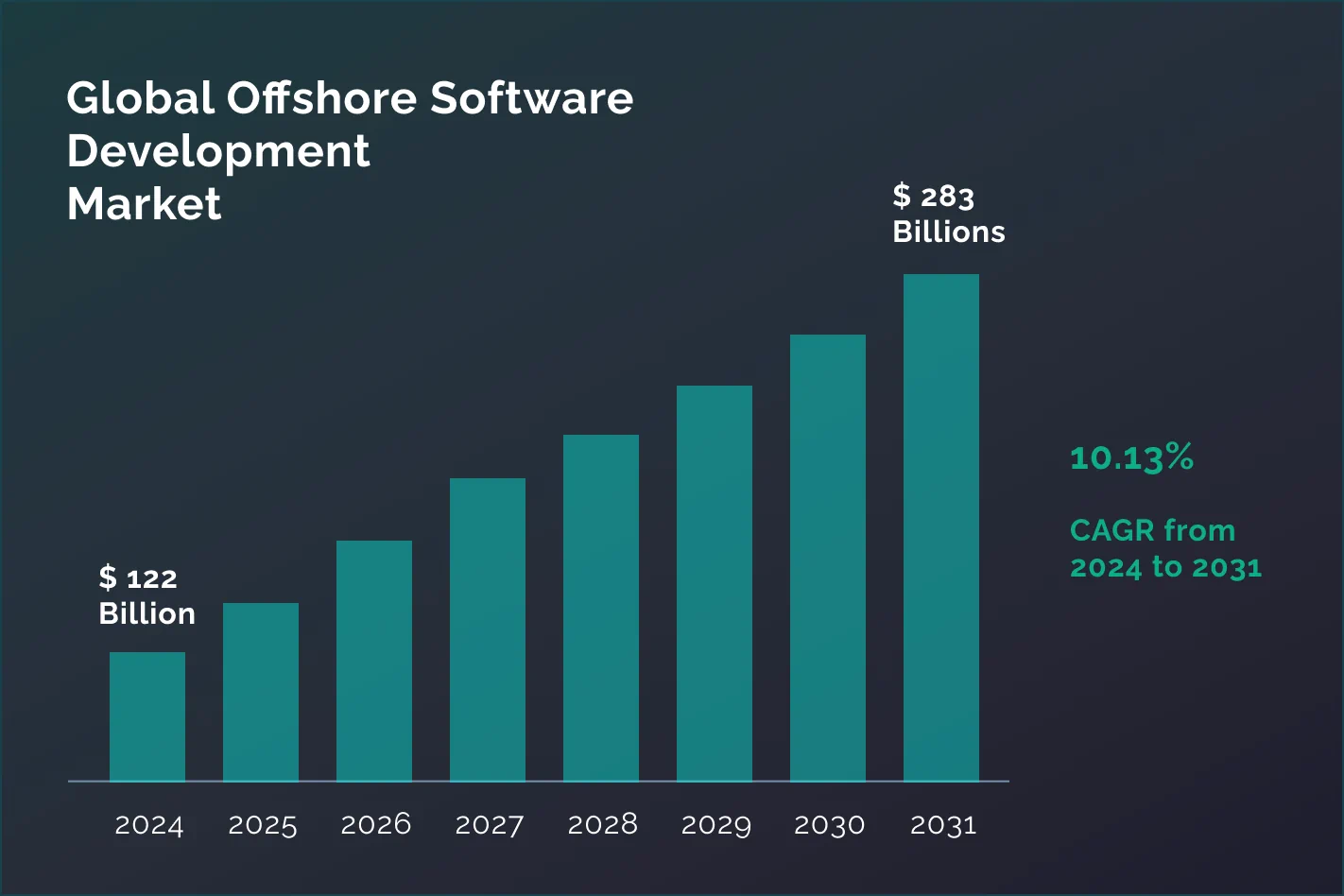Offshore Software Development: Everything You Need to Know

The problem of a skillful workforce shortage, which has always been one of the greatest challenges for entrepreneurs, is significantly alleviated by the across-the-board advent of the globalization drive. Modern communication platforms open the recruitment door wide for organizations across multiple verticals, enabling the offshore employment scheme.
Our article explains the essence of offshore development in the IT domain, analyzes the merits and demerits of offshoring software development, gives advice on selecting the right vendor, broaches the question of offshore software engineering cost, and outlines major trends in programming that will shape the industry for years to come.
What is Offshore Software Development?
Outsourcing is one of the buzzwords that can describe the global business landscape in the early 2000s. C-suite management at enterprises of all sizes increasingly realize that you don’t have to keep a team of high-profile specialists on your regular payroll if you need a one-off service from them here and now. To cut down on cost but enjoy qualified expertise in a limited-scope project, companies hire third-party employees for accounting, logistics, marketing, copywriting, legal services, customer support, and other shop floor tasks.
The utilization of outsourcing is especially widespread among large businesses, while 37% of smaller organizations delegate at least one business process to an external company, taking the average outsourcing penetration rate to a staggering 80%. As a result, the global outsourcing market is experiencing a sharp spike, growing at a solid CAGR of almost 10% and forecasted to surpass $525 billion within five years.
The outsourcing system has become especially popular and thriving in the IT sector, with 76% of businesses preferring it over in-house software development for at least one function. In this field, the outsourcing scheme comes in three models.
- Onshore outsourcing is a cooperation model in which an organization finds a partner from the same country, which allows it to run a pretty tight ship regarding collaboration and project execution.
- Nearshoring refers to hiring a service provider from a neighboring country with a minimal time zone difference.
- Offshore software outsourcing boils down to enlisting the professional help of an IT vendor located far from the client, typically on another continent thousands of miles away.
Each model has its pros and cons, but it is offshore software development outsourcing that carries the day in the contemporary business realm. The offshore development outsourcing market, which had a value of $122 billion last year, is projected to soar more than twofold by 2031, displaying a more than decent CAGR of 10+%.

In what software building areas is the offshore model especially efficient?
Custom software development
Bespoke products should be created with an eye to the unique needs and requirements of a specific customer. Offshore developers can meet their clients halfway concerning all aspects of the future solution and ensure its seamless integration with the existing IT environment.
Mobile app development
As smartphone ubiquity increases exponentially, the demand for such products is on the rise. Organizations poised to launch their mobile applications often can't find technical experts in their region, so offshore application development is the only way out for them.
Web development
Web solutions are also at the top of the most-wanted list among software products since establishing a digital footprint is a must for any company with big aspirations. In highly developed countries, IT vendors with the requisite competence are hard to come by, which urges entrepreneurs to opt for offshore software product development.
IT support and maintenance
Software solutions require constant monitoring, security patching, performance auditing, updating and upgrading, adding new features, etc. That is why, alongside offshore programming, offshore IT maintenance and support services are gaining considerable traction nowadays.
Benefits of Offshore Software Development

By outsourcing IT product development to a far-off vendor, organizations enjoy the following perks.
Cost saving
This is the primary reason organizations adopt the offshoring business model. Labor costs in North America or Western Europe are considerably higher than, say, in Eastern and Central Europe (Ukraine, Poland, Romania, or the Czech Republic). Hiring an IT team from this area can radically diminish custom software development costs.
Access to a wider talent pool
The absence of local specialists with relevant competencies is no longer an impossible obstacle to business success. You can hire skilled professionals from anywhere on Earth, choosing experts according to your wallet size and project requirements.
Shorter time-to-market
If you need a software product yesterday, you can recruit several development teams from different time zones. The work on the project will literally proceed round the clock, allowing them to complete it on short notice.
Scalability and flexibility
Whenever necessary or when current circumstances demand it, you can upscale the development crew to reach maximum speed and efficiency and downscale it as soon as the crisis is over or the work is done.
Focus on core business functions
If you are a non-tech enterprise, setting up an IT department is a tall order. It requires knowledge you don't have and takes up a lot of your precious time. Delegating software projects to an offshore vendor allows you to attend to errands you are good at and entrust things in which you understand nothing to vetted professionals in the sphere.
Challenges of Offshore Software Development

Being in the outsourcing market for quite a time, we know everything about the bottlenecks of managing a remote development team.
Time zone discrepancy
As a rule, working with an offshore vendor means cooperating with developers located on the opposite side of the globe whose working hours barely match yours. To address the challenge, the project manager should devise a communication schedule to suit all stakeholders.
Communication barriers
These can occur in any project, but for offshore cooperation, they demand special attention. Such barriers appear because of cultural and language differences between parties, as well as because of inadequately organized interaction. You can overcome communication roadblocks by setting up a transparent interaction link between the outsourcer and the client, establishing timely reporting, envisaging control measures, and partnering with an outsourcer closer to you in terms of culture and language.
Quality control and code consistency
It’s hard to predict exactly what to expect of code quality during offshore software development until you start your cooperation (unless you have worked with the company before or have access to feedback and reviews). To minimize the chances of poor product performance, you should be very careful while selecting an outsourcer for your project.
Data security and compliance issues
Entrusting your company's sensitive data to a third party always entails a risk of leakage or loss. A Non-Disclosure Agreement (NDA) is a crucial document that should be signed with the vendor to forestall such incidents and adhere to data protection norms — both general, like GDPR, or industry-specific, like HIPAA — adopted by national and international legal frameworks.
The good news is that most of these challenges can be mitigated at the stage of vendor selection.
How to Choose a Proper Offshore Development Partner

There are several aspects you should pay attention to when picking a vendor for your software project.
Location
It affects the hourly rates the vendor charges and the time zone difference you will have to address. Other factors influenced by the outsourcer's location are cultural practices (communication style, approach to task completion, decision-making techniques, attitudes toward conflict, etc.) and the language in which development team members are fluent.
Technical expertise and experience
By studying the potential candidate’s website, you can learn about their experience of working in the offshore outsourcing market and see the tech stack the team wields (preferably vindicated by corresponding certificates).
Industry-specific knowledge
The partner-to-be should be well-versed in the vertical the future solution belongs to — tourism, logistics, healthcare, fintech, insurance, you name it — and have a proven track record or team members with hands-on experience in similar projects.
Client testimonials
You should read reviews from the vendor's former partners placed on the site to see how satisfied they were with the cooperation process and the final product they obtained as a result. To make doubly sure, contact them in person and learn other details you are interested in that weren't mentioned in the testimonials. Other sources of such information are vendor rating platforms like Clutch and GoodFirms.
Communication and collaboration
Successful communication in offshore cooperation is mission-critical. You should be able to choose collaboration channels you are comfortable with and establish a communication schedule convenient for both of you.
Security and compliance standards
Security-minded vendors always offer an NDA to safeguard your intellectual property rights and have various security certificates to display that prove their adherence to legal standards in the niche.
All these factors considered, Implex is your number one choice for an offshore software development partner. Our qualified and certified professionals possess the necessary theoretical knowledge and top-notch practical competencies to implement a software project of any scope and complexity. We are very rigorous in everything that concerns our partners’ interests (data security, code quality, project budget, timeline, etc.) but manifest utmost flexibility in our cooperation style, adjusting communication schedules and pricing models to the customer’s preferences and tastes.
Cost of Offshore Software Development

The budget you will have to allocate for an offshore software project is influenced by the following factors.
The developer’s hourly rates
These depend on the region the vendor hails from. The highest prices are charged by North American and Western European companies ($100–150), whereas the lowest ones can be found in South Asia ($30–40).
Project complexity and scope
A simple solution with a limited number of capabilities and an elementary tech stack to develop will certainly cost you less than a feature-rich product with cutting-edge technologies it is equipped with.
Team composition
The skeleton team for a garden-variety software project consists of a project manager, a front-end developer, a back-end specialist, a UI/UX designer, and a QA engineer. Any new member on the list spells larger expenditures.
Completion urgency
The sooner you need the solution done, the more overtime effort it will require, which will have to be paid at special rates.
Engagement models
There are three basic outsourcing engagement models: fixed price, time & material, and dedicated team. Each has its pros and cons cost-wise, so you should make sure the one you opt for suits your project to a tee.
What are the best practices for offshore software development cost optimization? You should remember that optimization isn't about being lean and mean and going for the lowest price possible. Doing this will make you penny-wise but pound-foolish in the long run since product quality will suffer. Instead, you should strike a healthy balance between all expenditure items and find the best price/quality ratio in all choices.
Offshore Software Development Trends: Today, Tomorrow, and Beyond

What are the latest developments in offshore software programming that are likely to determine the industry's face in the foreseeable future?
AI-driven automation
The demand for faster SDLC and shorter time to market accounts for a high degree of automation in the software building pipeline. Equipped with AI-based tools, offshore vendors pave the way for dramatic acceleration of development speed by automating tasks and introducing AI-fueled code generation, bug detection, and testing workflows.
Prioritizing cybersecurity
As cyber threats become more sophisticated, strong data protection and solution inviolability issues come to the forefront. Offshore teams are expected to harness DevSecOps practices and adopt a security-first approach at all software development stages to prevent system compromise and build reliable barriers that are impossible for cybercriminals to penetrate.
The rise of hybrid and remote work models
The onslaught of the global pandemic has changed people's attitudes to many things and ruined numerous stereotypes, including those that established work organization principles. Companies across multiple verticals are switching to hybrid and remote models, allowing employees to attend to their responsibilities from home. The offshore system is highly flexible and susceptible to such innovative initiatives, providing software engineers with a choice concerning the working environment as long as the productivity and efficiency of their performance stay at the appropriate level.
To Sum Things Up
Nowadays, many companies outsource various workflows to third-party organizations located in the same country (onshoring model), a neighboring country (nearshoring model), or a distant country (offshoring model). The latter system is especially beneficial in the field of software development, promising businesses substantial cost reduction, access to a qualified global workforce, great flexibility and team scalability, and swift completion of software projects while staying focused on their core business processes.
However, when choosing offshore outsourcing software development, an organization should be ready to address challenges such as time zone and cultural differences, communication issues, quality control, and data security. These can be overcome by choosing the right offshore partner that possesses relevant technical competence and experience, has industry-specific capabilities, adheres to security and compliance standards, and has been highly assessed by previous clients.
Implex ticks all these boxes. We can build a software solution of any type and complexity within time and budget that will satisfy all your quality, performance, and design requirements. Get in touch with us, and let’s discuss the details of your project.



